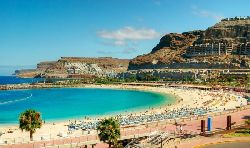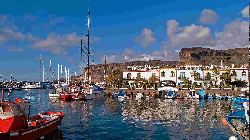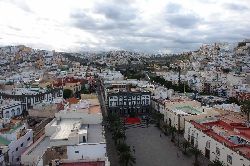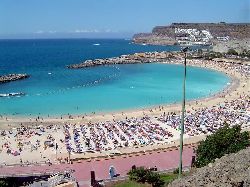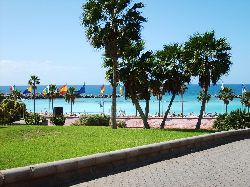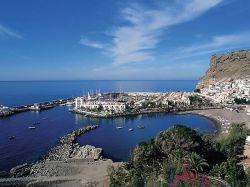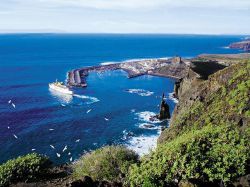Common description
Gran Canaria (Spanish: Gran Canaria) is one of the Canary Islands with 807 thousand inhabitants. The main city - Las Palmas - the administrative center of the province of the same name.
The island is one of the centers of tourism in Spain. The travel motto is “Gran Canaria - Continent in Miniature”.
The island of Gran Canaria has an almost round shape, located in the southern part of the Canary Archipelago. An amazing feature of such a relatively small island is the sharp change in natural areas, from high forested mountains, on the tops of which there is almost always snow, to sunny beaches with the finest golden sand.
The area of Gran Canaria is 1532 square meters. km The coast is 236 km long, about 50 of which are occupied by beaches, most of which are concentrated in the south. Among the beaches of Gran Canaria, Maspalomas stands out especially, a dune beach with a length of 8 km and a width of 2 km. This is a real mini desert by the sea with a palm oasis. Dunes are a national wildlife park.
The mountains divide the island into two parts, the locals call them simply - South and North. Both parts are distinguished by the diversity of the landscape and the rich nature. The island is even called a continent in miniature. The valleys here are adjacent to the mountains, deserts with rainforests and banana plantations.
The island's capital, Las Palmas de Gran Canaria, has more than five centuries. This is one of the largest ports in the Atlantic Ocean, which was founded by conquistador Juan Rehon in 1478. Almost half of the island's population lives here.
The best place for walking is Canteras Boulevard, which stretches for 4 km, where there are many hotels, restaurants, cafes and shops.
In the north of the island, near the town of Galdar, is La Cueva pintada. This is a cave of tufa with cave paintings, which is more than 2 thousand years old. This is the only cave where the drawings have retained their color to this day.
The Canary Botanical Garden on the slopes of the Giniguada Gorge, 7 km from Las Palmas, contains all the plants of the Canary Islands and Macronesia (Azores, Madeira, Cape Verde).
Telde is the second largest city on the island. 4 km from the city rises Montagna de Cuatro Puertas, on the northern slope of which near the large cave with four entrances is located the esplanade. This is the site where the Guanches once held Council meetings.
Puerto de Mogan - the so-called "Canary Venice". This fishing village 40 km from Maspalomas has now become a modern fishing and sports port and is very popular among yachtsmen.
10 km from Las Palmas is the crater of La Caldera de Bandama, which belongs to the craters of recent formation, has 1000 m in diameter and 220 m in depth. Going down the path to the bottom of the crater, you can see the farm buildings. The best view of the crater opens from the peak of Bandama (575 m). Not far from La Caldera de Bandama is the village of La Atalaya, famous for its pottery, which are made according to the ancient Guanche recipe.
The island is one of the centers of tourism in Spain. The travel motto is “Gran Canaria - Continent in Miniature”.
The island of Gran Canaria has an almost round shape, located in the southern part of the Canary Archipelago. An amazing feature of such a relatively small island is the sharp change in natural areas, from high forested mountains, on the tops of which there is almost always snow, to sunny beaches with the finest golden sand.
The area of Gran Canaria is 1532 square meters. km The coast is 236 km long, about 50 of which are occupied by beaches, most of which are concentrated in the south. Among the beaches of Gran Canaria, Maspalomas stands out especially, a dune beach with a length of 8 km and a width of 2 km. This is a real mini desert by the sea with a palm oasis. Dunes are a national wildlife park.
The mountains divide the island into two parts, the locals call them simply - South and North. Both parts are distinguished by the diversity of the landscape and the rich nature. The island is even called a continent in miniature. The valleys here are adjacent to the mountains, deserts with rainforests and banana plantations.
The island's capital, Las Palmas de Gran Canaria, has more than five centuries. This is one of the largest ports in the Atlantic Ocean, which was founded by conquistador Juan Rehon in 1478. Almost half of the island's population lives here.
The best place for walking is Canteras Boulevard, which stretches for 4 km, where there are many hotels, restaurants, cafes and shops.
In the north of the island, near the town of Galdar, is La Cueva pintada. This is a cave of tufa with cave paintings, which is more than 2 thousand years old. This is the only cave where the drawings have retained their color to this day.
The Canary Botanical Garden on the slopes of the Giniguada Gorge, 7 km from Las Palmas, contains all the plants of the Canary Islands and Macronesia (Azores, Madeira, Cape Verde).
Telde is the second largest city on the island. 4 km from the city rises Montagna de Cuatro Puertas, on the northern slope of which near the large cave with four entrances is located the esplanade. This is the site where the Guanches once held Council meetings.
Puerto de Mogan - the so-called "Canary Venice". This fishing village 40 km from Maspalomas has now become a modern fishing and sports port and is very popular among yachtsmen.
10 km from Las Palmas is the crater of La Caldera de Bandama, which belongs to the craters of recent formation, has 1000 m in diameter and 220 m in depth. Going down the path to the bottom of the crater, you can see the farm buildings. The best view of the crater opens from the peak of Bandama (575 m). Not far from La Caldera de Bandama is the village of La Atalaya, famous for its pottery, which are made according to the ancient Guanche recipe.
Gran Canaria on map
+14°C

